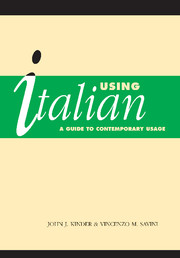Book contents
- Frontmatter
- Contents
- Preface and acknowledgments
- Abbreviations
- 1 Varieties of language
- WORDS AND THEIR MEANINGS
- 2 Misleading similarities
- 3 Fields of meaning – “Synonyms”
- 4 Complex verbal expressions
- 5 Affective suffixes
- 6 Idioms, similes, and proverbs
- 7 Personal names
- 8 Geographical and astronomical names
- 9 Abbreviations and acronyms
- 10 Latin expressions and sayings
- 11 Grammatical terms
- 12 Numerals and telephone conventions
- 13 Measurement
- THE CLAUSE – combining words
- THE SENTENCE – combining clauses
- TEXTS AND THEIR STRUCTURE
- Bibliography
- Italian word index
- Grammar index
9 - Abbreviations and acronyms
Published online by Cambridge University Press: 05 June 2012
- Frontmatter
- Contents
- Preface and acknowledgments
- Abbreviations
- 1 Varieties of language
- WORDS AND THEIR MEANINGS
- 2 Misleading similarities
- 3 Fields of meaning – “Synonyms”
- 4 Complex verbal expressions
- 5 Affective suffixes
- 6 Idioms, similes, and proverbs
- 7 Personal names
- 8 Geographical and astronomical names
- 9 Abbreviations and acronyms
- 10 Latin expressions and sayings
- 11 Grammatical terms
- 12 Numerals and telephone conventions
- 13 Measurement
- THE CLAUSE – combining words
- THE SENTENCE – combining clauses
- TEXTS AND THEIR STRUCTURE
- Bibliography
- Italian word index
- Grammar index
Summary
The abbreviations and acronyms in use in Italian are many and ever changing. The following conventions apply generally in Italian.
For all measurements (metric, scientific etc.) the abbreviations used in Italian follow international conventions.
Words are usually truncated after a consonant or cluster of consonants, e.g. part.(icipio) pass.(ato). Days and months, on the other hand, are often found abbreviated after their third letter, e.g. gio for giovedì, ago for agosto. A shortened form is sometimes followed by the last letters of the word, e.g. Gent.mo for Gentilissimo.
In acronyms, the plural is sometimes indicated in writing by doubling the initial letter, e.g. AA VV for Autori vari; in some truncated words, the last letter (consonant) may be found repeated, e.g. pagg. for pagine as opposed to pag for pagina.
The shortening of words is mainly a writing expedient and truncated words are mostly read in their full form: Sig. is always read “signor(e).”
Acronyms, on the other hand, are pronounced and can be written as normal nouns whenever possible, e.g. UFO, which is read “ufo” and can be found written Ufo or ufo. In some cases, however, a letter by letter reading is unavoidable, e.g. BBC, pronounced “bi-bi-cì”. There are also some “hybrid” forms, such as CGIL (a trade union), pronounced “ci-gi-elle,” with “gi” incorporating “i,” or RAI TV, pronounced “rai ti-vù.”
- Type
- Chapter
- Information
- Using ItalianA Guide to Contemporary Usage, pp. 207 - 216Publisher: Cambridge University PressPrint publication year: 2004



